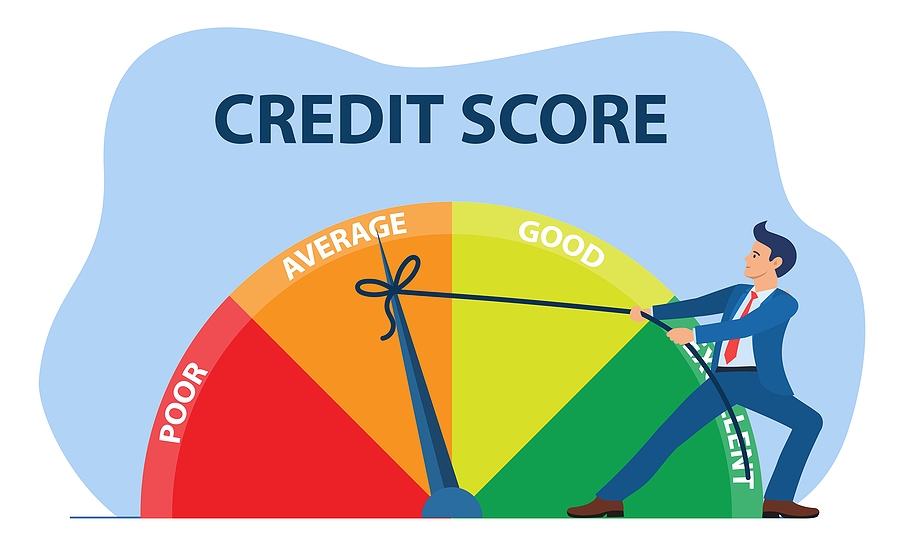

Your credit score is a seemingly simple three-digit number, but it can have a major impact on your finances. Without a high score, you may not be able to pursue some of your major financial goals. Or even if you can, those goals can actually turn into major challenges if you’re stuck with high interest rates because you had a low score. If you are preparing to improve your credit, you need to know the general ranges for scores so that you can set a specific goal for yourself. There are various tiers of credit scores, and being in a higher tier will generally bring the reward of better terms.
First, What’s the Average?
We’re going to talk about credit score categories in a moment, such as “poor,” “fair,” and “good.” But first let’s take a look at the average credit score. One initial point of clarification—while there are two major credit scoring models—FICO and VantageScore—we will focus primarily on the FICO score in this article, though we will make brief mention of the VantageScore as well. There are actually multiple FICO scoring models, and lenders use a variety of them, but the information here specifically relates to FICO® Score 8.
FICO most recently reported that the average credit score is 706. Credit scores nationwide can fluctuate significantly depending on the state of the economy. Back in 2009, the average was 686. COVID-19 and other economic factors may have a negative impact on the national average, but only time will tell. The average can be a useful baseline for comparing your own score. But, don’t let the average discourage you if your score is lower, because there are many ways to increase your score.
Source: FICO.com
The Breakdown
Using the FICO 8 scoring model, the credit bureaus agree (see Experian’s post here and Equifax’s here) to the following breakdown for score ranges. Again, remember that your lender may use a different model which could result in a slightly different breakdown. But, this should give you a good general idea of what to aim for.
Poor
A poor credit score is a score between 300 and 579.
Fair
A fair credit score is a score between 580 and 669.
Good
A good credit score is a score between 670 and 739.
Very Good
A very good credit score is a score between 740 and 799.
Excellent
An excellent credit score is a score between 800 and 850.
If you are curious about the breakdown for VantageScore 3.0, it looks like this:
- Very Poor: 300-499
- Poor: 500-600
- Fair: 601-660
- Good: 661-780
- Excellent: 781-850
Interestingly, the VantageScore ranges are narrower on the low end of the spectrum (including both a “very poor” and “poor” range, and broader on the high end (including only a “good” and “excellent,” without a “very good” range).
Why the Ranges Matter
Now that you know the ranges, here are three important reasons that they matter.
- Access to Credit and Other Services
If your score is too low you may not have access to credit or, at the very least, you will likely have obstacles to credit. A score in the “very poor” range may mean that any applications for credit are denied. Your best bet may be a secured credit card, which requires you to make a deposit. While this is not ideal, a secured card can be an important tool in rebuilding your credit.
Also, remember that getting credit is not the only concern. Access to other products and services often depends, in part, on your credit history. Being in the “very poor” range can limit your ability to rent an apartment, enter certain contracts, or even get a job.
- Favorable Credit Terms
Even if you can get credit, you will want the credit terms to be as favorable as possible. Bad credit terms, like high interest rates, will make your debt more expensive. They will also limit your purchasing power, which can prevent you from buying the home or car you want. Every time your score improves from one category to the next (say from “fair” to “good”), that should be paired with lenders offering you more favorable terms.
Here is a look at estimated mortgage rates by credit score and a look at auto loan rates by credit score. Note: these tools use different ranges and terminology for scores (for instance, the auto loan chart has ranges from “deep subprime” to “super prime”), but the general point still applies.
- Goal Setting
Knowing the general credit score ranges can help you plan your goals for the future. Make a plan to check your credit score frequently, but especially as you make major changes (paying off a debt, opening a new card or loan, or changing your credit limit). You will also need to check your credit report often, as that report is the basis for your score. Keeping a close eye on these will help ensure that you move your credit in the right direction.
Want a free credit report review? An NFCC-certified counselor can review your credit report with you, and help you make a game plan for improving your financial standing. Learn more about the free credit report review, or get started here.